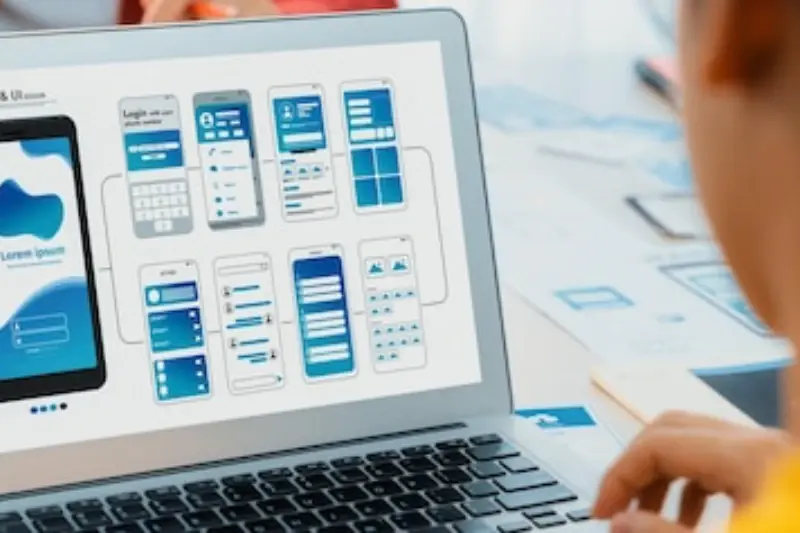Calculate Your App's Success Probability in 5 Steps
Have you ever wondered why some apps become household names whilst others disappear without a trace after just a few months? The difference isn't luck—it's proper planning and realistic assessment before a single line of code gets written. After eight years of building mobile apps for everyone from ambitious startups to established brands, I can tell you that the most successful projects always start with one thing: calculating their app success probability before diving into development.
Most people approach app development backwards. They fall in love with their idea, start sketching designs, maybe even begin coding, and then wonder why downloads are disappointing or revenue isn't materialising. This approach wastes time, money, and frankly, a lot of emotional energy too.
The best time to evaluate your app's chances of success is before you build it, not after you've spent your budget
Smart app planning means conducting a thorough feasibility evaluation—examining market demand, understanding your competition, checking technical requirements, calculating resources needed, and validating your revenue model. This systematic approach to app viability assessment helps you make informed decisions based on real data rather than hopeful assumptions. The five-step process we'll explore isn't about crushing dreams; it's about turning good ideas into successful apps by understanding what you're up against and what you'll need to win. Whether your app idea keeps you excited or you're still weighing up different concepts, this framework will help you calculate your genuine probability of success before you invest serious time and money.
Step 1: Market Demand Analysis
Before you write a single line of code or sketch your first wireframe, you need to figure out if anyone actually wants what you're planning to build. I've seen too many brilliant app concepts fail because the developers assumed there was demand without properly checking first.
Market demand analysis isn't just about asking your mates if they'd use your app—though that's a decent starting point. You need to dig deeper and understand whether there's a genuine need for your solution in the real world.
Where to Find Real Demand Data
Start by looking at app store search volumes for keywords related to your idea. Tools like Google Keyword Planner or App Store Optimisation platforms can show you how many people are actively searching for solutions like yours. If nobody's searching, that's either a red flag or you've stumbled onto something completely new.
Social media platforms are goldmines for understanding user frustrations. Search for complaints about existing solutions in your space—Reddit, Twitter, and Facebook groups are particularly useful for this. When people are actively moaning about current options, that's where opportunity lives.
Measuring Market Size
Once you've confirmed there's interest, you need to size the opportunity. Look at these key indicators:
- Monthly search volumes for relevant keywords
- Download numbers of similar apps (use tools like Sensor Tower)
- Social media group sizes focused on your problem area
- Industry reports and market research studies
- Survey responses from your target audience
Don't expect massive numbers straight away. Even a niche market with 10,000 potential users can be profitable if you solve their problem well enough. The key is making sure those people exist and that they're willing to pay for a solution.
Step 2: Competition Assessment
Right, let's talk about your competition—because whether you like it or not, they're out there. I've worked on hundreds of app projects, and I can tell you that every single one had competitors. Even the most unique ideas face competition from apps that solve similar problems or target the same audience.
Start by identifying your direct competitors; these are apps that do exactly what yours will do. Then look at your indirect competitors—apps that solve the same problem but in a different way. For example, if you're building a meditation app, your direct competitors are other meditation apps, but your indirect competitors might include fitness apps with mindfulness features or even music streaming services with relaxation playlists.
What to Look For
When analysing your competition, focus on these key areas:
- App store ratings and number of downloads
- User reviews and common complaints
- Features they offer (and what they're missing)
- Pricing models and monetisation strategies
- Marketing approach and user acquisition methods
- Update frequency and development activity
Don't just look at what they're doing well—pay close attention to what users are complaining about. Those complaints are gold mines for understanding market gaps you could fill.
Check if the top competitors haven't updated their apps in months. This could signal a market opportunity, but it might also mean the market isn't profitable enough to sustain ongoing development.
Making Sense of the Data
If you find dozens of successful competitors, that's not necessarily bad news. It means there's a proven market demand. But if the market is completely saturated with well-funded apps, you'll need a really strong differentiator to break through. Consider whether you should choose a competitive or niche category for your app.
Step 3: Technical Feasibility Check
Right, you've checked the market and scoped out your competition—now comes the bit that separates the dreamers from the doers. Can your app actually be built? This isn't about crushing dreams; it's about being realistic before you invest time and money into something that might not work.
Technical feasibility is about understanding what's possible with current technology and what isn't. Some app ideas sound brilliant on paper but require technology that doesn't exist yet or would cost millions to develop. Others might need access to data or systems that simply aren't available to the public.
Key Technical Questions to Ask
Start by breaking down your app's core features. What does it actually need to do? Does it require real-time data processing, complex algorithms, or integration with third-party services? These aren't deal-breakers, but they affect complexity and cost.
- Does your app need special hardware features like advanced camera functions or sensors?
- Will it work offline or does it need constant internet connection?
- How much data will it store and process?
- Does it need to integrate with existing systems or APIs?
- What level of security does it require?
Don't worry if you can't answer all these questions yourself—that's normal. The point is to identify potential roadblocks early. Speaking with a technical expert at this stage can save you from nasty surprises later.
Platform Considerations
Think about which platforms you'll target. iOS and Android have different capabilities and limitations. Some features work beautifully on one platform but are restricted on another. Battery usage, processing power, and storage limitations all play a part in what's feasible for your specific app idea.
Step 4: Resource Requirements Evaluation
Right, let's talk money and time—the two things that can make or break your app before it even gets started. I've watched brilliant app ideas die simply because people didn't properly evaluate what they'd need to bring them to life. It's not just about having a great concept; you need the resources to execute it properly.
Your resource requirements fall into three main buckets: budget, time, and team. Budget isn't just the development cost—you'll need money for design, testing, marketing, ongoing maintenance, and those inevitable changes that crop up during development. Most people underestimate by at least 30%, so build that buffer in from the start.
Time and Team Considerations
Time is trickier than budget because it affects everything else. A simple app might take 3-4 months; complex ones can stretch to 12 months or more. Your timeline impacts your costs, your market entry, and your team's availability. Speaking of team—do you have the right people? If you're outsourcing, have you researched agencies properly? If you're building in-house, do your developers have mobile experience? You might wonder can I build a cross-platform app with a small team—it's certainly possible with the right approach.
The biggest mistake entrepreneurs make is thinking they can build an app on a shoestring budget and expect it to compete with well-funded alternatives
Be brutally honest with yourself here. If your resource requirements don't align with what you can realistically access, your app success probability drops significantly. Sometimes the smartest move is to simplify your initial version or wait until you have adequate resources. Better to build something excellent later than something mediocre now.
Step 5: Revenue Model Validation
Right, let's talk about money—because that's what keeps the lights on and pays for all those lovely app updates. I've seen brilliant apps fail spectacularly because nobody thought about how they'd actually make money. Don't be that person!
Your revenue model isn't just about picking between adverts or subscriptions; it's about understanding what your users are willing to pay for and when they're willing to pay it. Are you solving a problem that people will happily open their wallets for? Or are you banking on showing them enough adverts to cover your costs? If you're building something like a dating app, you'll need to think carefully about how to make money without ruining the user experience.
Testing Your Pricing Strategy
Before you commit to any pricing structure, you need to validate it with real people. Create simple landing pages with different price points and see which gets the most interest. Run surveys asking potential users what they'd pay for your solution—but remember, people often say they'll pay more than they actually will when the time comes.
Understanding Your Revenue Timeline
Here's where many app founders get unstuck: they expect immediate returns. Most successful apps take months to find their revenue sweet spot. Subscription apps typically see higher lifetime values but slower initial growth, whilst one-time purchases might give you quick cash but less long-term stability.
Look at your competitors' pricing models and user reviews. What are people complaining about? Are they saying it's too expensive, or are they happy to pay but want more features? This gives you valuable insight into market expectations and pricing tolerance.
Conclusion
Right then—you've worked through all five steps of app success probability evaluation, and hopefully you've got a clearer picture of where your app idea stands. Whether the results are encouraging or a bit sobering, you're now in a much better position than most people who jump straight into development without doing this feasibility evaluation first.
The truth is, calculating your app's success probability isn't about getting a perfect score across all areas. It's about understanding the real challenges and opportunities ahead of you. Maybe your market demand analysis showed strong potential, but your competition assessment revealed some tough rivals. Or perhaps your technical feasibility check highlighted some complex requirements that will need extra attention during mobile app planning.
What matters most is that you're making informed decisions. Each step we've covered—from market demand to revenue model validation—gives you data to work with rather than gut feelings alone. And trust me, data beats assumptions every single time when it comes to app viability assessment.
If your evaluation shows green lights across most areas, brilliant! You're ready to move forward with confidence. If there are red flags, don't see this as failure; see it as saving yourself time, money, and frustration down the line. Sometimes the best decision is to pivot your idea or wait until conditions improve.
The mobile app world moves fast, but taking time for proper evaluation before you build will always pay off. Your future self will thank you for doing the homework first.
Share this
Subscribe To Our Blog
You May Also Like
These Related Stories

7 Critical Questions Before Building Your Mobile App

How to Turn Your Website Into a Progressive Web App (step-By-Step)





